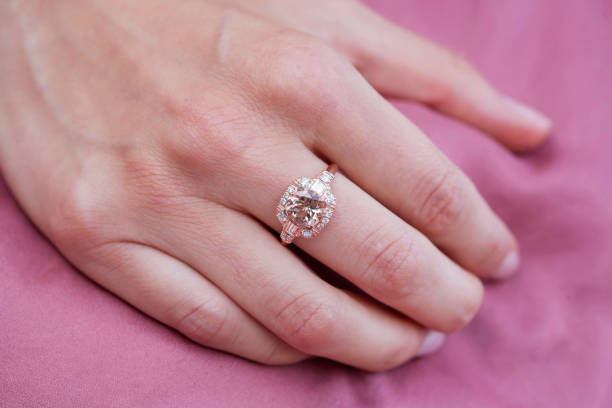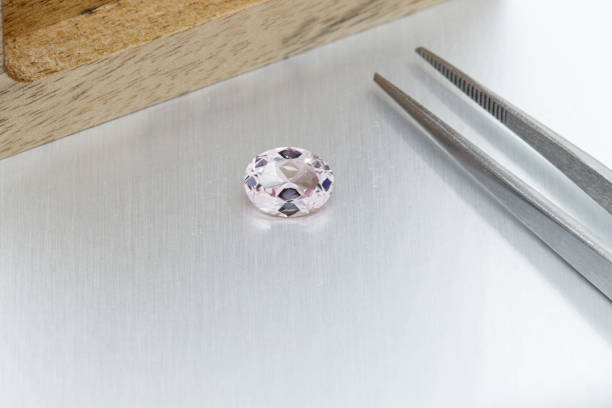Do You Know the Other Side of Morganite?
0 comments
SHOP BY STYLE ✧
SHOP BY SHAPE ✧
![]()
![]()
![]()
![]()
![]()
METAL COLOR ✧
WEDDING BANDS
SHOP BY STYLE ✧
![]()
![]()
![]()
SHOP BY STONE ✧
SHOP BY METAL ✧
JEWELRY FOR THE BIG DAY
NECKLACES ✧
EARRINGS ✧
BRACELETS ✧
Engagement ✧
SHOP BY SHAPE ✧
![]()
![]()
![]()
![]()
![]()
![]()
SHOP BY COLOR ✧
SHOP BY CATEGORY✧

FEATURED✧
SHOP BY CATEGORY✧
SHOP BY OCCASION✧
SHOP BY PRICE✧

Birthstone Jewelry

Morganite’s allure in the jewelry world is not just a product of its captivating hues but also its impressive physical and optical properties. Understanding these characteristics is essential for both gemologists and enthusiasts, as they influence how morganite is valued, cut, and set into jewelry. Here, we’ll delve into the physical and optical properties that make morganite a gemstone of choice for an array of exquisite jewelry pieces, explore the aspects that make morganite a standout in the world of jewelry.
Morganite is a member of the beryl family, which includes other notable gemstones such as emerald and aquamarine. Its chemical formula is Be₃Al₂(SiO₃)₆, with traces of manganese causing its pink color. This beryllium aluminum silicate has a hexagonal crystal system, contributing to its durability and the potential for large, clean gemstones that are ideal for cutting and polishing.
The most distinctive optical property of morganite is its color. Morganite’s palette ranges from a soft, pale pink to a more robust salmon and, occasionally, a deeper violet-pink. The intensity of its color largely depends on the concentration of manganese within the crystal structure. Some morganite stones undergo heat treatment to enhance or stabilize their pink hue, a common practice that can deepen the color to make it more appealing.

Morganite typically exhibits high clarity with few inclusions visible to the naked eye, making it an excellent choice for large statement pieces where the gemstone’s purity can be showcased. When cut and polished, morganite displays an attractive vitreous luster, contributing to its eye-catching brilliance and ensuring it captures light beautifully.
On the Mohs scale of mineral hardness, morganite ranks between 7.5 and 8, making it quite resistant to scratches and abrasions. This level of hardness, combined with its high clarity, contributes to morganite’s suitability for everyday wear, particularly in items like engagement rings and pendants. However, like all gemstones, it should be treated with care to avoid harsh impacts that could cause chipping or cracking.
Lorem ipsum dolor sit amet, consectetur adipiscing elit. Ut elit tellus, luctus nec ullamcorper mattis, pulvinar dapibus leo.

Morganite has a refractive index ranging from 1.572 to 1.600, which measures how much light is bent, or refracted, as it passes through the gemstone. This property, along with its dispersion (how much it spreads white light into the colors of the spectrum), influences morganite’s brilliance — the way it sparkles when light is reflected from its interior. The gemstone’s cut plays a crucial role in maximizing this effect, with well-proportioned facets enhancing its natural radiance.
Morganite exhibits pleochroism, meaning it can show different colors or intensities of color when viewed from different angles. This optical property can display variations from pink to clear or pink to violet, depending on the stone and its orientation. Cutters often consider this when shaping the gemstone to ensure the most attractive color presentation from the top view.
Morganite’s combination of physical and optical properties — its range of pink hues, clarity, durability, and brilliant luster — make it a favored gemstone for jewelry. Its hardness ensures longevity, while its color and clarity offer a visually stunning appearance.
Morganite has surged in popularity as a choice for fine jewelry, celebrated for its soft pink to peach hues that exude warmth and sophistication. This gemstone’s appeal in the jewelry market is attributed to its unique blend of visual beauty, durability, and versatility, making it a preferred option for everything from statement pieces to everyday wear.
The appeal of morganite in jewelry has grown significantly over the past few decades, driven by consumers’ increasing interest in colored gemstones as focal points in engagement rings and other fine jewelry. Its soft pink color offers a romantic and feminine alternative to more traditional stones, aligning with contemporary trends that favor personal expression and uniqueness in jewelry choices.
Morganite’s color range from pale blush to deeper peach tones makes it a versatile choice for a variety of jewelry settings and styles. Its warm tones pair beautifully with both white and yellow metals, offering flexibility in design. Rose gold, in particular, complements morganite exceptionally well, enhancing its pink hue and creating a cohesive, warm look that has become highly sought after for engagement rings and bridal jewelry.
Engagement rings featuring morganite center stones have become increasingly popular for those seeking a distinctive and elegant alternative to traditional diamonds. Morganite offers a compelling combination of beauty, durability, and affordability. When set alongside diamonds, morganite’s subtle color is accentuated, creating a stunning contrast that highlights the best features of both stones. Designers often employ halo settings, where morganite is encircled by diamonds, to amplify its presence and sparkle.
Morganite’s hardness (7.5 to 8 on the Mohs scale) makes it suitable for everyday wear, though it’s still important to treat it with care to prevent scratches or damage. Its durability, coupled with the stone’s enchanting aesthetics, has made morganite a popular choice not just for engagement rings but for a range of jewelry pieces, including earrings, necklaces, and bracelets. For special occasions, larger morganite pieces set in intricate designs can serve as glamorous statement jewelry, while smaller, more understated pieces are perfect for adding a touch of elegance to everyday outfits.
As with many gemstones, there’s a growing demand for morganite to be sourced and produced responsibly. Consumers are increasingly aware of the origins of their gemstones, seeking assurance that their purchases are ethically sourced and contribute positively to the producing communities. LisaJewelryUS is responding by providing more transparency and ensuring their morganite adheres to ethical standards.
To maintain its beauty, morganite jewelry should be cleaned regularly. A simple solution of soap and warm water, used with a soft brush, is effective for removing dirt and oils. Though the stone is relatively hard and durable, it should be protected from harsh chemicals and extreme temperature changes, which could damage the stone or affect any treatments it may have undergone.
Morganite’s allure in jewelry is undeniable. Its unique color, durability, and versatility make it an attractive choice for a variety of jewelry pieces, from engagement rings that capture the heart to everyday items that add a touch of elegance. As consumers continue to seek out gemstones that offer both beauty and value, morganite stands out as a gemstone that meets these desires, solidifying its place in the world of fine jewelry.